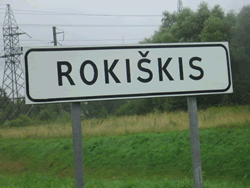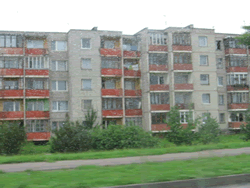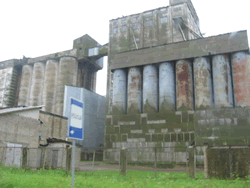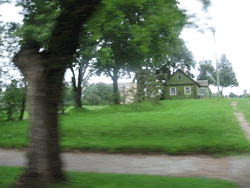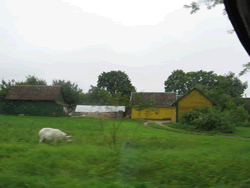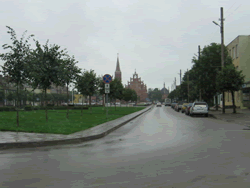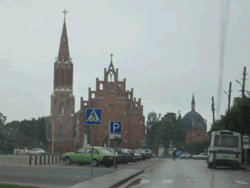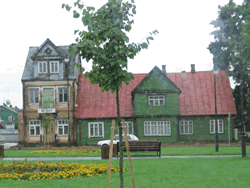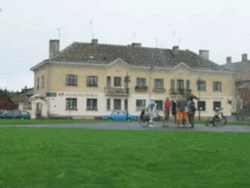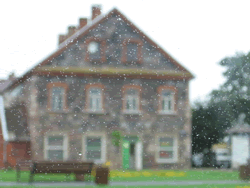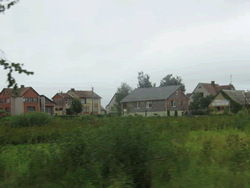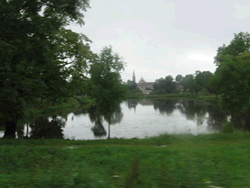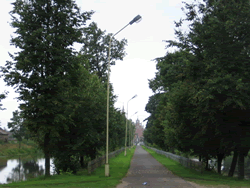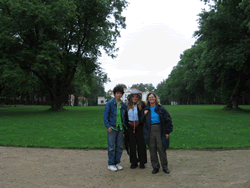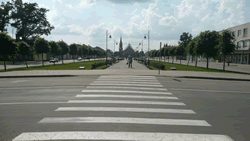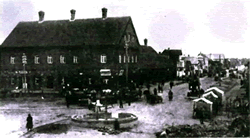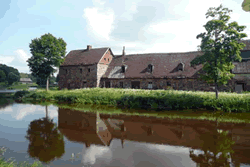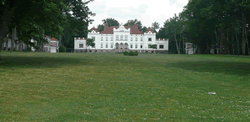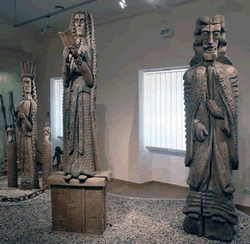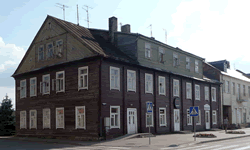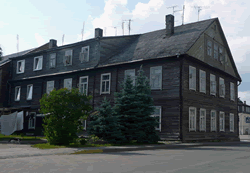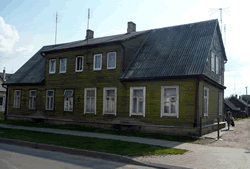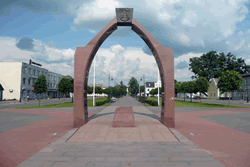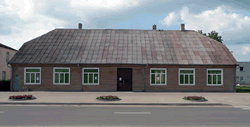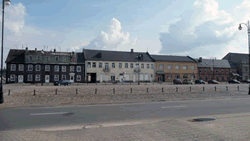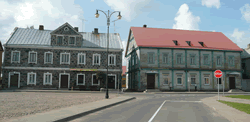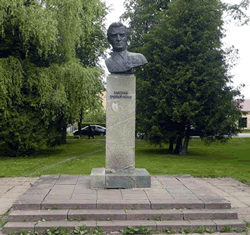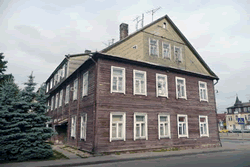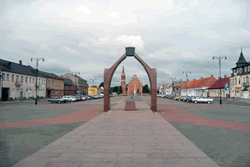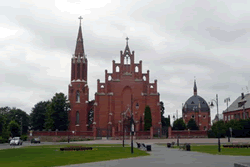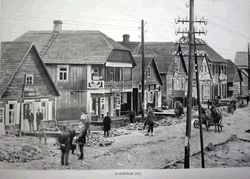|
#rok_ns-1:
|
#rok_ns-2:
|
|
#rok_ns-3:
|
#rok_ns-4:
|
|
#rok_ns-5:
|
#rok_ns-6:
|
|
#rok_ns-7:
|
#rok_ns-8:
|
|
#rok_ns-9:
|
#rok_ns-10:
|
|
#rok_ns-11: |
#rok_ns-12: |
| #rok_ns-13: |
#rok_ns-14: |
#rok_ns-15: |
#rok_ns-16: |
| http://byebyecanberra.blogspot.com/2011/06/walking-in-their-footsteps-part-1.html ....grandfather's family hails from a small town in North-Eastern Lithuania called Rokiskis - it also happens to be the capital of the region by the same name. This is where my grandfather was born and lived until he left for South Arica with his mother and three sisters at the ripe old age of 9, in 1929. His two brothers had already emigrated years earlier, as children. | |
#rok_ns-17: Standing at the Eastern end of Independence Square, facing West |
#rok_ns-18: A photo of that same house, taken in the 1920's My grandfather's family lived on Khamyer Gas, now called Republikos Gatve (the main street), but I do not know the address, nor do I know whether their house is indeed still standing. It didn't matter though, walking around this town which to some extents, was still part of the 19th century, made me feel that much closer to my ancestors. It was as if I had some better taste of their lives. I could picture them as kids playing in the backstreets, the parents going about their business in the streets. It was great just to be able to look at 'real' things which were just as they were when my family lived there - the imposing St Mathews Church on the Western end of the square, and the magnificent Count's residence a short way off to the East. |
#rok_ns-19: Dilapidated buildings along the short walk to the manor |
#rok_ns-20: |
#rok_ns-21: The Rokiskis Museum is housed in a manor which was built for Count Ignotas Tyzenhauzas in 1801, and renovated a couple of times since. The last Tyzenhauzas (who was actually a woman and therefore bore a different name) eventually left Rokiskis when the Bolsheviks moved in. Somehow, the museum got a hold of the manor to use as a museum (the fact that this is not very well explained, leads me to believe that the building wasn't exactly 'bequeathed' to the museum...) |
#rok_ns-22: Apart from seeing a really cool old fashioned manor house, the museum has a collection of wooden sculptures by the local artist, Lionginas Sepka. Although I'm not an art fanatic, some of these sculptures were really cool. Perhaps it was also the sheer number that this guy created over the years, and the intricate nature of some of the installations. If you happen to be in Nortth-Eastern Lithuania - it's worth a visit! I stayed in the old section of town (the new centre of town is around 2km to the South) only 2 blocks from Independence Square. This wasn't so much by choice, but more down to the fact that there isn't much of a choice of hotels in town, and there is even less of a choice when it comes to hotels that will pick up the phone when you try and call them to make a reservation! |
#rok_ns-23: Right in the centre of the square, across from what used to be the town well, is an old black timber house. To the outsider, the house looks much like many of the other early 20th century houses in the town which in any other modern city, would have been torn down a long time ago. However, this house, on the South-West corner was built in 1920 by 2 cousins of my grand-father's mother - Pesach & Rachmiel Ruch. |
#rok_ns-24: |
#rok_ns-25: |
#rok_ns-26: |
#rok_ns-27: Standing in the centre of Independence Square, facing West (towards the Manor) |
#rok_ns-28: |
#rok_ns-29: On the ground floor, the familes had their retail shops, and on the first floor, four families lived. Famously, when the Lubavitche Rebbe visited Rokiskis in 1931, this is the house he stayed at. The house was nationalised by the government when the Soviet Union took control of Lithuania. It was during this time (1950-1952) that a reconstruction took place and the house was subdivided into many more, smaller units. |
#rok_ns-30: The following photos are some of the typical early 19th century buildings that make up most of 'old town' Rokiskis in the 21st century... |
#rok_ns-31: There is not a single mention, anywhere in town - memorials or otherwise - about it's Jewish past. Prior to the war there were only a few thousand residents and approximately half of them were Jewish. Now there are around 16,000 residents, and not a single Jew amongst them. They were all either driven out, or killed. I do wonder though, how many of houses that people live in now, are actually legally owned by them, and how many were simply taken over. How much of the town would be as it was were it not for the significant proportion of its population that no longer exists? Interestingly, and ironically, there is a bust in one of the main parks of the town's most favourite child, Yakov Smushkevich who was commander of the Soviet Air Force in the early 1940's. He even became a Hero of the Soviet Union for his contribution to the Spanish Civil War. He was a Jew. Anonymous16 June 2011 5:39 pm Kevin1118 June 2011 8:28 am |
#rok_ns-32: |
#rok_ns-33: Standing in the centre of Independence Square, facing West (St Mathew's Church) |
#rok_ns-34: Rokiskis isn't much of a town. In fact, apart from the Count's Manor and the imposing St Mathew's Church in the old town square, there isn't much of a reason any tourists would visit it. And it shows. The old town is centred around Nepriklausomybes, or Independence Square. To be perfectly honest, the church does stand out and really is the feature of the town's skyline. It's unique gothic like structure is quite imposing and provides a very unique view of the town. Another traveller has taken some fantastic photos (more here) of the town, so I have limited the number I have put up. |
#rok_ns-35: Rokiskis today (same as 85 years ago - but with TV antennas!) |
#rok_ns-36: |
#rok_ns-37: Rokiskis when my grandfather was a child |
#rok_ns-38: |
#rok_ns-39: |
#rok_ns-40: |
#rok_ns-41: |
#rok_ns-42: |
New Jewish Monument in Rokiškis (Rákeshik), Lithuania, Commemorates 3 Synagogues
8 September 2015
E V E N T S / O P I N I O N
by Defending History Staff
For many years, international visitors to Rokiškis (in Yiddish: Rákishok, or less formally: Rákeshik), in northeastern Lithuania, have remarked that the town’s central area seemed to preserve little (or no) trace or commemoration of its erstwhile Jewish population, though a large monument graces the entrance to the old Jewish cemetery outside town. Before the Holocaust, this town was home to around 3,500 Jews (some 40% of the total population, and the overwhelming majority in its central area). Luckily, a short film of pre-Holocaust Jewish Rákishok survives (from 1937), and is available on Youtube. As for many towns that were on the territory of interwar Lithuania, one of the best sources remains Berl Kagan’s Yiddish encyclopedic classic, Jewish Cities, Towns and Villages in Lithuania (New York 1991, pp. 545-547). A full translation into Lithuanian is in progress under the auspices of the Jewish Cultural and Information Center in Vilnius.
Nearly all the town’s Jews perished in the Holocaust. The Holocaust Atlas of Lithuania enumerates four local mass graves with a total of 5,415 recorded victims. Three of them contain the remains of a total of 4,434 regional Jews murdered. A fourth, with 981 victims, is a site where suspected Communists and former Communist Youth members were killed, with a recorded ethnic breakdown of 493 Jews, 432 Russians and 56 Lithuanians.
This past Sunday, 6 September, a major advance was made in the context of the European Day of Jewish Culture. Antanas Vagonis, the mayor of Rokiškis was the keynote speaker at a meticulously organized ceremony held to unveil a large, handsome trilingual plaque commemorating the town’s three destroyed synagogues, which had been painted, in turn, red, yellow, and green, to collectively reflect the three colors of the Lithuanian flag during the years of the interwar republic as a symbol of civic solidarity and national loyalty.
The ceremony was opened by a captivating poetry recital by Vil? Sarulien? of a series of poems by Matilda Olkinait?. The commemoration project per se was presented by Giedrius Kujelis, head of the history department of the Rokiškis Regional Museum. Other local personalities who spoke were the region’s heritage protection specialist Audron? Gav?nien? and the local museum’s director, Nijol? Šniokien?.
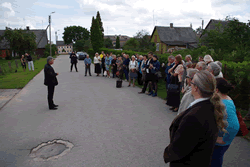
Algis Gurevi?ius (left), director of the Jewish Cultural and Information Center in Vilnius, addresses the assembled at the unveiling of the memorial for the town’s three main synagogues, all destroyed. Photo: Julius Norwilla.
The event’s Vilnius-based partner at the event was the Jewish Cultural and Information Center, itself a partner project of the Jewish Community of Lithuania and the Vilnius Municipality. The JCIC was represented by a small delegation led by the center’s founder and director, Algis Gurevi?ius, who addressed the modest but enthusiastic small crowd on the importance for Lithuania of commemorating local and national Jewish heritage in a serious way and with practical achievements. He was followed by Professor Dovid Katz, who spoke in Yiddish, and was translated by Julius Norwilla. According to the museum’s report of the event, this represented a moment of note, as Yiddish had not been heard on the town’s streets for over seventy years. He distributed some copies of his map of historic Jewish Lithuania as a symbolic gift to the townspeople. The event was covered by the Lithuania Tribune (English Delfi.lt). A photo album of the event was issued online by the local museum and another was posted by Julius Norwilla. There is a video of Mayor Antanas Vagonis’s speech, of which the municipality released this English version:
First of all, I would like to thank the coordinators of our [Rokiškis Regional] museum, who undertook this nice initiative. As you know, the process of reviving Jewish symbols began a very long time ago. And not long ago, when I myself was working for the municipal public works council, the sculptor, Albertas Jasi?nas, told me that he would need help in installing the memorial stone near the gates of the Jewish cemetery. And I told him that we would help, that it would not be a problem, that we could do it quickly, and that there would be no charge at all.
As you know, historically, and my advisor made some research, some time ago there was a large Jewish community [in this town], and the Jewish residents even outnumbered the Lithuanians.
It is very well said that we need to revive historical things. And today I want to touch upon the subject of bridges. Bridges serve not only for remembering and showing these cultural features but those bridges should also serve to invite people to come back over these bridges.
I know that our ethnic groups have been put into confrontation, and not just for one year. And for some things we should feel ashamed before your nation and some other nations. And we are constantly being put into confrontation with the Russians, and with the Poles, and even with our neighbors the Latvians, let alone the Jews.
We have to look at things the way they are now and think. There are no bad peoples, maybe only bad leaders of those peoples. It is not the fault of the Russians that they have such a leader as Putin, it is understood. Neither is it the fault of the Latvians or the Jews that they have been singled out. Indeed, every nation has an outstanding personality.
We are expressing our joy that you have not forgotten us. And I want to say more: Send a message to the whole world that if someone is longing for and would like to get back to their motherland, we are looking forward to your coming back. And I believe that, step by step, we have to come back. And, on my behalf, I promise that our people will treat all nations with respect – with great respect.
And now, I thank you, all, and I thank everyone who worked to make this beautiful informational sign.
This was followed by the much-anticipated unveiling.
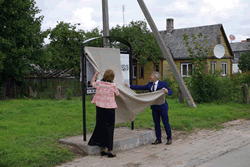
Unveiling the memorial to the three destroyed synagogues. Photo: Julius Norwilla.
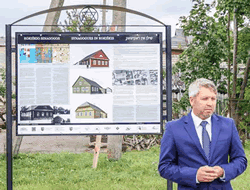
Mayor Vagonis at the new memorial, with images of the prewar red, green and yellow synagogues in the central panel. They were color-coordinated to celebrate the tricolor Lithuanian flag. Photo: Rokiškis Regional Museum.
The historic text on the trilingual plaque does not, unfortunately, mention the (massive) local collaboration in the Nazi extermination of its Jewish population; as is frequently the case, this occasions omitting to speak about the local rescuers (Righteous of the Nations) who can and should be the greatest inspiration to today’s youth. The Yiddish text is replete with embarrassing errors, starting with the very title. It is important that when including Yiddish in public memorials, municipal authorities consult proper experts. These deficiencies can be repaired, the visitors were assured, by an eventual updating of the image layer using the same metal stand erected, all thanks to the wonders of modern technology.
Following the event, the visitors from Vilnius were treated to an extensive historic walking tour stressing sites of Jewish interest, followed by a tour of the town’s historic palace, now home to the county seat’s regional museum. This was graciously led by the museum’s historian Giedrius Kujelis, who spared no effort to answer all questions with the greatest of care. Before return to Vilnius, visitors were treated to a delicious selection of the town’s famous cheeses, well known to all visitors to Lithuania and the region.
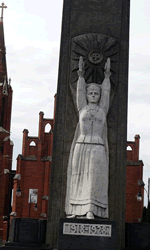
The Rokiškis town square swastika. Photo: DefendingHistory.com.
It is not possible to write about a visit to Rokiškis without mentioning the disturbing monument in the center of the town square, facing the massive nineteenth century church. It is a nationalist statue featuring a statue of a woman worshipping toward heaven with a swastika above her head and partly between her hands. The year marking 1918-1928 quickly confirms that it is an interwar, pre-Nazi-invasion work, from when the swastika was one of many symbols toyed with by nationalists and ultranationalists, particularly aryan-purist worshippers, but without the later Hitlerist connotation of obligatory racial hate or eliminationist antisemitism. During the 2010 legal proceedings at which the swastika was controversially legalized by a Lithuanian court, the case of the prewar Rokiškis town center monument was prominently cited. It was explained to the visitors last Sunday that during the Soviet period, the swastika was artfully hidden so that the authorities did not suspect its presence, saving the monument from removal or destruction. It was again proudly uncovered after independence.
All said and done, it continues to be a blemish on the town’s international standing that its square continues to feature a swastika that inspires today’s neo-Nazis across Lithuania, in the absence of curatorial or historic comment in an accompanying text, and in the ongoing absence of any mention of the town’s Jewish population of 3,500 loyal citizens, or their annihilation, in the town square per se.
It might not hurt to move the swastika monument from the town square to the regional museum and supply it with ample curatorial warning about the use of the symbol in the movement that murdered nearly half the town’s population. At the same time, the town square might be adorned with a new monument that would, in the genuine spirit of the Grand Duchy of Lithuania, show respect of all the town’s historic peoples, precisely in the spirit of Mayor Vagonis’s address on the opening of the synagogue memorial stand on Sunday.
But these critiques of local policies do not — and must not — obscure or negate the very real progress made on Sunday when the proverbial ice was broken, by the town’s elected leadership, its museum’s academic directors, and the voluntary turnout of dozens of citizens spanning the generations, who were eager to be part of the historic moment when the public space regained something Jewish. It was particularly inspiring to see the keen interest by a number of young people who had only recently come to realize that their town was home to a people, language and culture of which so precious little remains to be found nearby.
Defending History's report / opinion piece on Sunday's important unveiling of a memorial in Rokiškis (Rákishok, Rákeshik, in northeastern Lithuania) to the town's three (destroyed) synagogues. While congratulating the town's leaders on this important advance, our team could not fail to have a strong opinion about the interwar monument in the heart of the town square, that features a historical swastika in the absence of curatorial comment...

New Jewish Monument in Rokiškis (Rákeshik), Lithuania, Commemorates 3 Synagogues | Defending History
DEFENDINGHISTORY.COM
